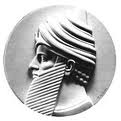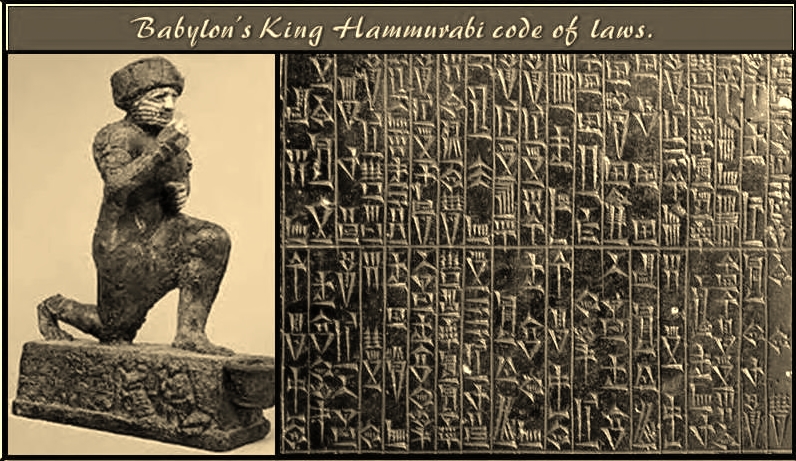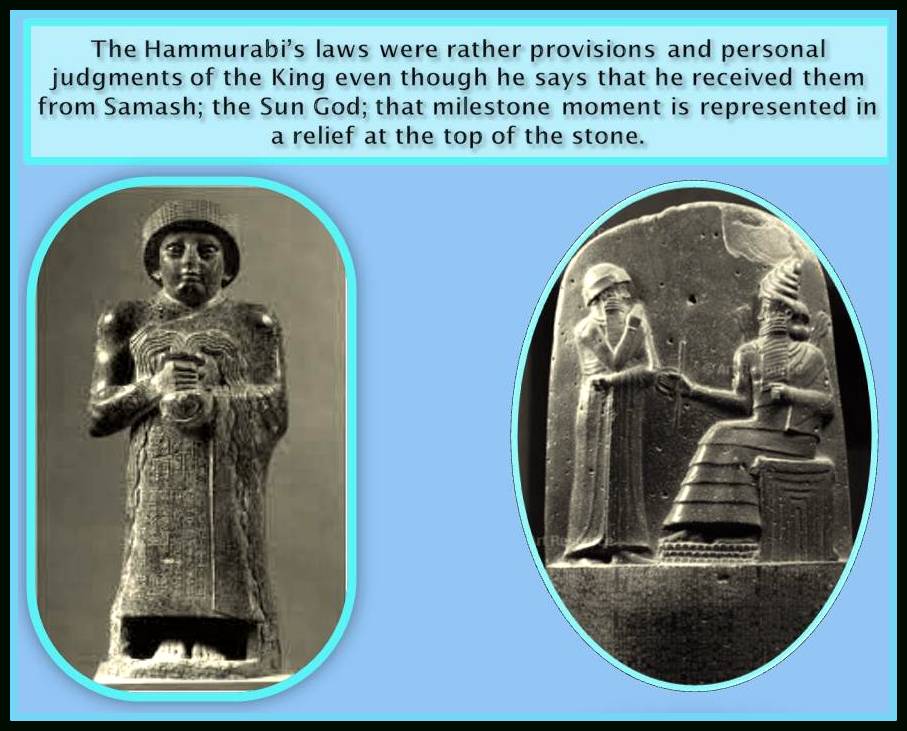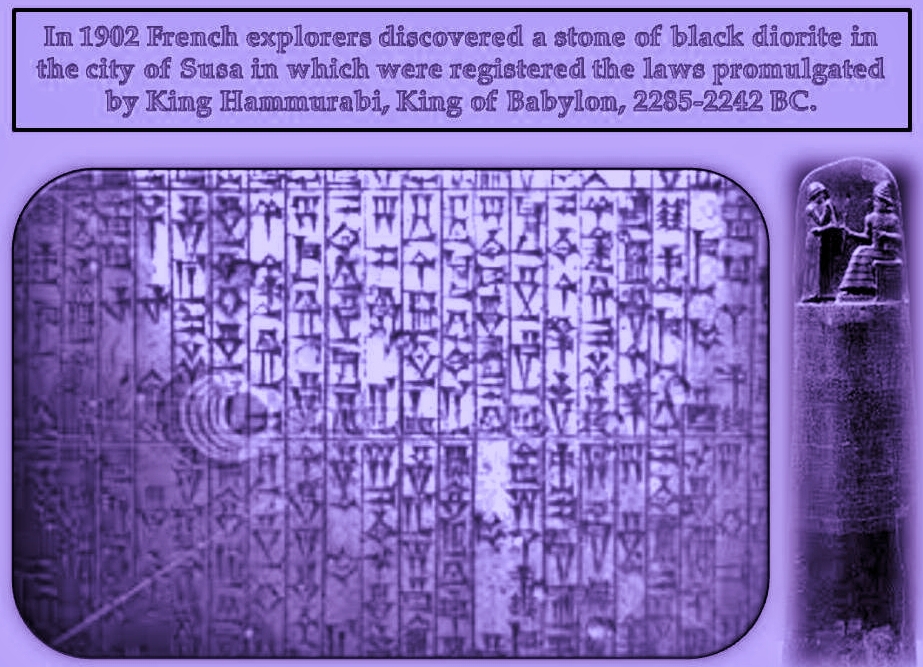
Babylonian King Hammurabi’s code of laws.
In 1902 French explorers discovered a stone of black diorite in the city of Susa in which were record the laws promulgated by King Hammurabi, King of Babylon, 2285-2242 BC. These so-called “laws” were somewhat personal determinations that the King promulgated as regards as justice and how should be provided in his Kingdom. He made sure however that what was stipulated therein were fulfilled and even terrible curses by his orders were also written for all those who would dare to change them or do not comply with them.
Despite these superstitious curses the laws were not preserved in their original entirety length; since in a remote past were erased approximately 34 sections of the stone. Not because they have been objected but as result of the column of black diorite fallen into the hands of a monarch who lived many years after the Hammurabi’s reign was over. He took the stone cylinder as a trophy of conquest and deliberately deleted those 34 sections from the base in the front to record therein his name when he move the column from Babylon to Susa where was later found.
The code of Hammurabi has an amazing property and that is the ability to be understood, its wisdom and understanding of human behavior; which is show clearly troughs the sections of the code destined to address the most important domestic aspects in the daily live of Babylon’s city people. It is not a surprise that many of its provisions are in force in the current legal system because they were foreseeing many of the possible situations that in general can occur in the individual’s social or private life.
Hammurabi says that he received this laws from Samash; the Sun God. That milestone moment is represented in a relief at the top of the black cylinder stone. Those laws are written in a way that attracts the attention of who reads them, rather unusual in comparison to the way in which were traditionally written in Mesopotamia cuneiform clay tablets; since these are commonly read in linear horizontally from left to right.
The code of Hammurabi is however written in the style of writing that was only used in sculptures and inscriptions with formal or solemn character. These laws made in a simplified style called ancient Babylon italics are written in short columns that are read from the top down; as you read the Chinese writing and they were written in the back and part of the front of the stone pillar in cuneiform writing hieroglyphs. These laws were divided into sections, each of which explains a trial that corresponds with a general law.
Although it was not the intrinsic purpose which they were written; however reveal important information for us today in relation to agriculture, society and its habits, trade, sex, politics, military life, inheritance, adoptions, the law over the private property rights as well as other aspects of the private life of citizens. This Babylonian code was predecessor in time to the short code of the exodus.
It is noteworthy that the criminal law section is rather brief since most of them correspond to aspects of civil law. The separation between civil and criminal law does not have a scientifically planned division demonstrating the spontaneity with which they were written. They contain principles in general about what is today considered jurisprudence, particularly; criminalization as a result to inflict harm or damage to others and the right for the affected part to be paid in retribution for the damages the other part cause.
While in many ways according to our modern vision of law, seeking justice they will reach extreme measurements as the famous law that stipulates eye for an eye, tooth for tooth, hand for hand and foot for a foot this laws accomplished to control and prevent the improper behaviors using an organize written form that establish the consequences of defiant them.
In those consequences can be mention; death by impalement, drowning and mutilations as retribution for the offense. Many of these laws that are so harsh and extreme as we would say today; come from accounts of exemplary punishments that correspond to former times previous to the time that the laws of Hammurabi were written and which correspond to stages more primitive or uncivilized, but perfectly in accordance with the hardness that it was traditionally dealt in the Mesopotamian region. Not that they were not applied in Hammurabi’s time though in all the rigor when was needed.
Although it does not appear to us that those laws contained in this Babylonian code are precisely mild, in some aspects; compared to the laws of other civilizations and cultures in different periods of mankind history and how they determined the punishment or justice applied to offenders, this Hammurabi’s laws are pretty mild indeed.
Curiously are absent from these Babylonian laws references about the theological or ceremonial aspects. This omission seems to indicate that there was a separation of the canonical laws from the State, we can infer that unlike laws in cultures and periods with monotheist religion; who successively develop in history and penalized with death to its citizens with religious differences, at less many Babylonians preserved their life thanks to the religious aspect not be contemplated in Babylon laws.
Hammurabi achieve in his quest from so remote time though give form to a code of law that gaze crucial aspects that are today contained as well in the modern laws of many countries. This advanced thinking that systematizes and governed by a written code to imposed justice and behavior of the citizens, reveals a high level in the development of this civilization and Hammurabi as a precursor for the establishment of these laws which he organized by intuition, personal experiences, the ones of his predecessors and his own conception about the right and wrong.
Bibliography
– Hammurabi Code and the Sinaitic Legislation W… (Paperback) by Chilperic Edwards. Watts & co. printers. London.
– Jenkins Owen B. The Code of Hammurabi compare with American law. Library of the University of Michigan. Law school. Gaylord Bros. Makers. Syracuse. N.Y.1908. Digitized copy by Google.



